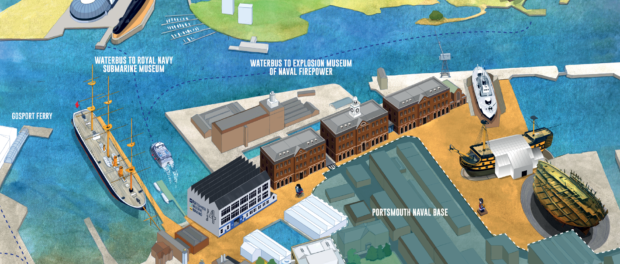A visit to the Historic Naval Dockyard Portsmouth
Yesterday I made a long-planned trip to the historic naval dockyards in Portsmouth organised by two friends in West Sussex – one a historian the other an ex-soldier.
As with many things planned well in advance, when the day came round it was not the most convenient as the weather was searingly hot and there was a rail strike.
 Also the organisation of the naval dockyards left much to be desired.
Also the organisation of the naval dockyards left much to be desired.
On arrival there was a long queue; that I had paid for the tour in advance – £35 – did not help. For some reason they had to change the ticket for another which took some 30 minutes.
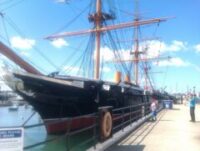 After recce-ing up with my friends inside the dockyards, which was a huge area, we visited our first ship HMS Warrior – the largest warship in the world at the time, built in 1861.
After recce-ing up with my friends inside the dockyards, which was a huge area, we visited our first ship HMS Warrior – the largest warship in the world at the time, built in 1861.
The French navy had built ironclad “ships of the line” with impenetrable armour, so it was back to the drawing board for the Royal Navy as wooden ships of oak were redundant.
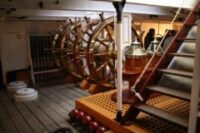 The Warrior was a mighty craft which attested to the fine shipbuilding of the era.
The Warrior was a mighty craft which attested to the fine shipbuilding of the era.
The only problem of the tour was the steepness of the stairs between galleys – the sort you use to get into the attic by ladder with a rope banister which made ascent and descent terrifying.
Nonetheless you had a precise picture of naval life and the reasons why the Royal Navy was so supreme.
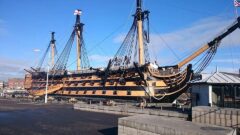 Our historian friend pointed out that for 100 years – between Trafalgar and Jutland – the Royal Navy did not fight a single major engagement as Britannia did indeed rule the waves.
Our historian friend pointed out that for 100 years – between Trafalgar and Jutland – the Royal Navy did not fight a single major engagement as Britannia did indeed rule the waves.
Our next port of call was HMS Victory.
 Unfortunately the exterior was being refurbished and covered in sheets, so you did not really have the picture of a ship, though you could visit the interior, again with steep stairs.
Unfortunately the exterior was being refurbished and covered in sheets, so you did not really have the picture of a ship, though you could visit the interior, again with steep stairs.
Napoleon had assembled an enormous fleet of French and Spanish vessels as a prelude to invading Britain. Nelson had assembled his out-numbered naval forces outside Cadiz and attacked the Franco-Spanish front-on, inflicting a major victory at Trafalgar.
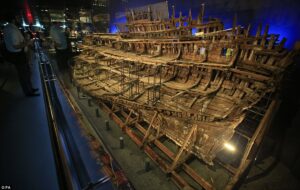 After an uninspired lunch in the Mary Rose cafe we did the tour of Henry VIII’s flagship the Mary Rose.
After an uninspired lunch in the Mary Rose cafe we did the tour of Henry VIII’s flagship the Mary Rose.
This set off from Portsmouth harbour to attack the French fleet late in the monarch’s reign and toppled over. Its remains were not recovered until 1982. I had visited before when all you could see was the side of the vessel being sprayed by water. Divers had recovered many artefacts, as with the two other boats, you had a clear picture of naval life below deck.
The Royal Navy plays an essential rôle in our Island Story.
Even as recently as the Second World War it was a feared force, which partially explains why Hitler never invaded Britain, and it imposed a blockade on Germany. Although the U-boats under Admiral Doenitz were effective in strangling Britain, the Germans never had a comparable navy.
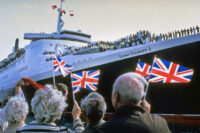 A year after the recovery of the Mary Rose, the Royal Navy successfully sent a task force to the Falklands.
A year after the recovery of the Mary Rose, the Royal Navy successfully sent a task force to the Falklands.
The naval dockyards are a fitting tribute but, boy, yesterday they were hard work and I was exhausted by the time Southern Fail got me home.

